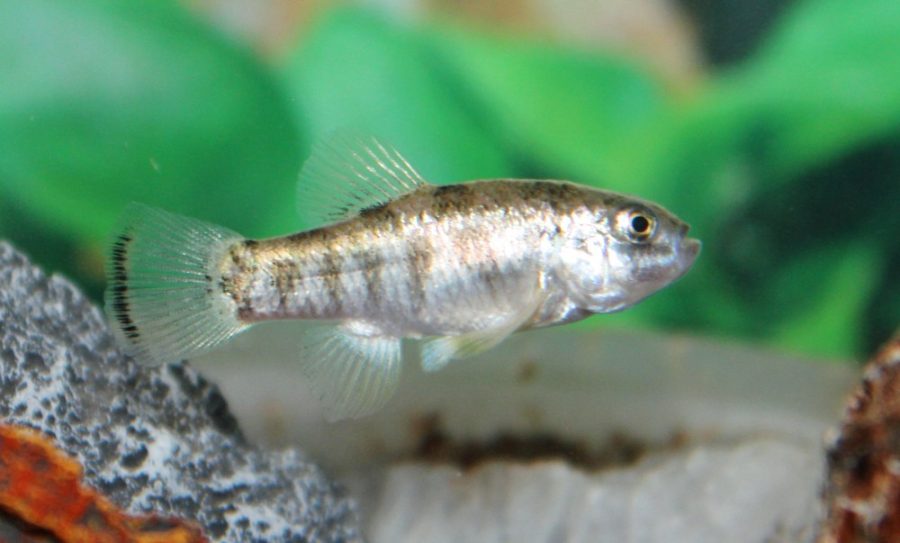Rio Sonoyta pupfish occur in only two wild places: Rio Sonoyta, in Sonora, Mexico; and Quitobaquito Pond, at Organ Pipe Cactus National Monument, Arizona.
However, they are now found at a handful of other locations, as a part of a conservation attempt by the Arizona Game and Fish Department and the U.S. National Park Service.

Recently, 300 of these endangered and endemic fish were relocated from a Tucson Safe Harbor Agreement-enrolled captive pond on the property of Bob Hernbrode, where they had been since 2009, when the pond began to fail.
Their new home will be the NPS-run Desert Research Learning Center in Tucson, in a artificial tinaja. A tinaja is a bedrock pond, well-scoured by water, sand and gravel. The goal of moving them into the new pond is to allow the population to grow larger and reduce the risk of genetic bottleneck.
As the Desert Research Learning Center is a NPS property, Rijk Morawe, general natural resources manager and biological scientist at Organ Pipe Cactus National Monument, thinks the fish will be safe there.
“Since they’re sitting in a national park, management will continue as it has been, and I don’t foresee a problem unless something happens to wipe out the entire population,” Morawe said.
RELATED: UA grad student researches impacts of drought on rural California
The Rio Sonoyta pupfish population has a complicated history, according to Morawe.
“The population got separated by a volcanic eruption, but there was [still a habitat] connection, and in years past it was consistent,” Morawe said. “But in the 1850s and 1860s residents created some damming of the connection and the fish got locked in.”
Ross Timmons, pupfish coordinator for the Arizona Game and Fish Department, said the Rio Sonoyta population and the Quitobaquito population are the same species, but are considered separate “evolutionarily significant units”, and therefore managed separately in order to preserve the species’ purity.
“The Rio Sonoyta population is a lineage of the same pupfish species that has been isolated since the last ice age,” Timmons said. “They went off on their own genetic trajectory.”
That they are genetically different is important, and a key driver of their separate conservation, Timmons said. The pupfish being relocated are the only stock of pure Rio Sonoyta lineage in the U.S., as they were brought from Sonora, Mexico in the 1970s.
“The whole idea behind conservation is to preserve what’s already on a landscape,” Timmons said. “If you preserve a hybrid, is that really what you were going for originally? No. You don’t want the lineage fuzzied up.”
RELATED: Water equity a focus at science diplomacy con
While there are some circumstances where hybrids would be introduced to pure populations to bolster numbers, Timmons said it’s a last resort.
“In some cases, when the original population reaches critically low levels, we don’t have a choice,” Timmons said. “But if you have large enough numbers, then you want to maintain those levels in refuge populations.”
As of now, there is no estimate on when some fish could be re-released into the wild. Due to habitat loss, groundwater pumping and declining surface water levels, Morawe said the pupfish’s native habitat is not stable enough.
“The issue is that the Rio Sonyota is an imperiled water system in Mexico,” Morawe said. “It’s difficult to say what may come of all this in the future. The hope is that Mexico would manage the water system a little better, but there’s a lot of agricultural pressure and the monsoon seasons have failed the past few years.”

Timmons said in 2012 and 2013, the area almost lost all surface water, and all the pupfish were living in a watering hole javelina had dug, and in a depression filled with water under a tree. However, the most NPS and Arizona Game and Fish can do is work with Mexico to save the habitat.
“We simply haven’t got any control over what happens in Mexico,” Timmons said. “All we can do is advise and encourage them.”
The conservation problem is larger than just pupfish, Timmons said. The habitat they live in is a specially-designated UN biosphere, and a large component of that recognition is flora and fauna. The loss of pupfish could have broad ecosystem ramifications.
“There’s probably a number of aquatic biota there, mud turtles, toads, we’ve got a few native species there,” Timmons said. “Without pupfish, there would likely be a decrease in the birds that came to feed. Any that used to stop in there to eat would be gone.”
Great blue herons, kingfishers, egrets and a number of other birds eat pupfish, but as they’re not dependent on the fish, Timmons said the larger issue would be the destruction or loss of the habitat overall.
NPS and Arizona Game and Fish will continue to monitor the fish in their new home, as well as continue to work to protect and preserve the wild pupfish and their habitat.
Follow Marissa Heffernan on Twitter.















